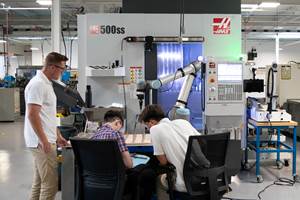High Speed Machining Helps Modernize Bulkhead Manufacturing
Raytheon Aircraft recently decided to set the competitive standard rather than follow it. In turn, the company is modernizing its manufacturing plants and processes to ensure continuous improvement.
Share





In its more than 65 years designing and manufacturing aircraft, Raytheon Aircraft Company (Wichita, Kansas) has held itself to a steadfast rule—there is always room for improvement. Raytheon Aircraft recently decided to set the competitive standard rather than follow it. In turn, the company is modernizing its manufacturing plants and processes to ensure continuous improvement.
The facilities are being enhanced from top to bottom, according to Larry Caspersen, director of two Raytheon Aircraft manufacturing plants, "All key processes conducted at our Wichita, Kansas, plants are being reconfigured into cells to maximize throughput and efficiency," he says. "Each year we manufacture and assemble more than 15,000 parts—it is essential that each one is perfect."
"The problem with conventional part manufacturing is the potential for human error," says Bill Jones, a Raytheon Aircraft manager of manufacturing and technical support. "Machining a part out of sheet metal and attaching multiple details onto it—angles, webs, beams, ribs, stiffeners and doublers—creates multiple tolerances. We realized parts like a forward pressure bulkhead can be designed more simply."
This prompted Raytheon Aircraft to investigate high-speed machining for part manufacturing. "High-speed technology allows us to reduce assembly by machining the forward pressure bulkhead from a single piece of billet aluminum," says Mr. Jones. "This creates an array of benefits, like eliminating the multiple tolerances associated with each detail, decreasing cycle time, and the bulkhead is more consistent, more accurate and more lightweight."
Raytheon Aircraft decided to use a Makino (Mason, Ohio) MC1516 high-speed horizontal machining center with a seven-pallet modular machining center (MMC) to support this bulkhead application. In two setups, the MC1516 machines thin wall tolerances under 0.00010 inch to near net shape. Roughing and finishing are conducted simultaneously using carbide end mills. Powered by the MC1516's Jet 50 spindle, these end mills reach 12,500 rpm and achieve metal removal rates as high as 320 cubic inches per minute.
"During installation the bulkheads fit perfectly, eliminating the need to trim and drill the part," says Bill Ohman, a Raytheon Aircraft machine shop manager. "Without rivets in the bulkhead, we also have a reduced part count and stronger parts without variation. We can even machine mating parts on the same machine."
The 15,000 rpm, 50 taper spindle provides horsepower at various ranges and brings a high level of rigidity to this application. With the seven-pallet MMC, the spindle is engaged more than 90 percent of the time. The MMC allows the company to conduct setup offline and keeps the MC1516 constantly fed.
One challenge Raytheon Aircraft foresaw with its modernization was the potential learning curve involved with new technology. The manufacturing team responsible for the bulkhead application worked to ensure the move to high-speed machining was seamless.
The team consisted of people in every discipline involved in the process, from manufacturing engineers to the operator. The team worked with Makino reviewing and optimizing the entire application prior to installation.
During this application review, several Raytheon programmers also visited Makino's Los Angeles-based Aerospace Technology Center to apply their programming skills to high-speed techniques. This paid off with production parts being machined immediately after installation.
Raytheon quickly realized the efficiencies, such as reduction in labor hours, that high-speed machining passed on to the rest of the manufacturing process.
Its approach to workholding also impacts setup, using what it refers to as universal vacuum fixturing. While the larger bulkhead is machined on a dedicated fixture, this approach to vacuum fixtures allows operators to set up smaller parts in one operation.
The fixturing uses back bolts and a large vacuum plate to hold the parts. The MC1516 first cuts the thinner, more sensitive areas that are more apt to flex away first, leaving more material for stability. If there is any angle on the web, it is cut prior to thinning it down. A thin foil web is ultimately cut around the floor of the part—about 0.0003 inch of material to keep the part attached to the universal fixture. When machining is complete, the vacuum is released and the part is snapped out of the surrounding material.
Ultimately, Tooling Manager Rob Luallen predicts certain applications could employ vacuum-free fixturing, and rely on the material surrounding the part for stability.
This exacting focus on process improvement has prepared Raytheon Aircraft to meet future demand and to consider new tools and capabilities.
Related Content
The Future of High Feed Milling in Modern Manufacturing
Achieve higher metal removal rates and enhanced predictability with ISCAR’s advanced high-feed milling tools — optimized for today’s competitive global market.
Read More4 Commonly Misapplied CNC Features
Misapplication of these important CNC features will result in wasted time, wasted or duplicated effort and/or wasted material.
Read MoreCNC Machine Shop Honored for Automation, Machine Monitoring
From cobots to machine monitoring, this Top Shop honoree shows that machining technology is about more than the machine tool.
Read MoreBallbar Testing Benefits Low-Volume Manufacturing
Thanks to ballbar testing with a Renishaw QC20-W, the Autodesk Technology Centers now have more confidence in their machine tools.
Read MoreRead Next
Machine Shop MBA
Making Chips and ¸ßĹâÂĘÁůşĎ˛Ę are teaming up for a new podcast series called Machine Shop MBA—designed to help manufacturers measure their success against the industry’s best. Through the lens of the Top Shops benchmarking program, the series explores the KPIs that set high-performing shops apart, from machine utilization and first-pass yield to employee engagement and revenue per employee.
Read MoreAMRs Are Moving Into Manufacturing: 4 Considerations for Implementation
AMRs can provide a flexible, easy-to-use automation platform so long as manufacturers choose a suitable task and prepare their facilities.
Read More




















